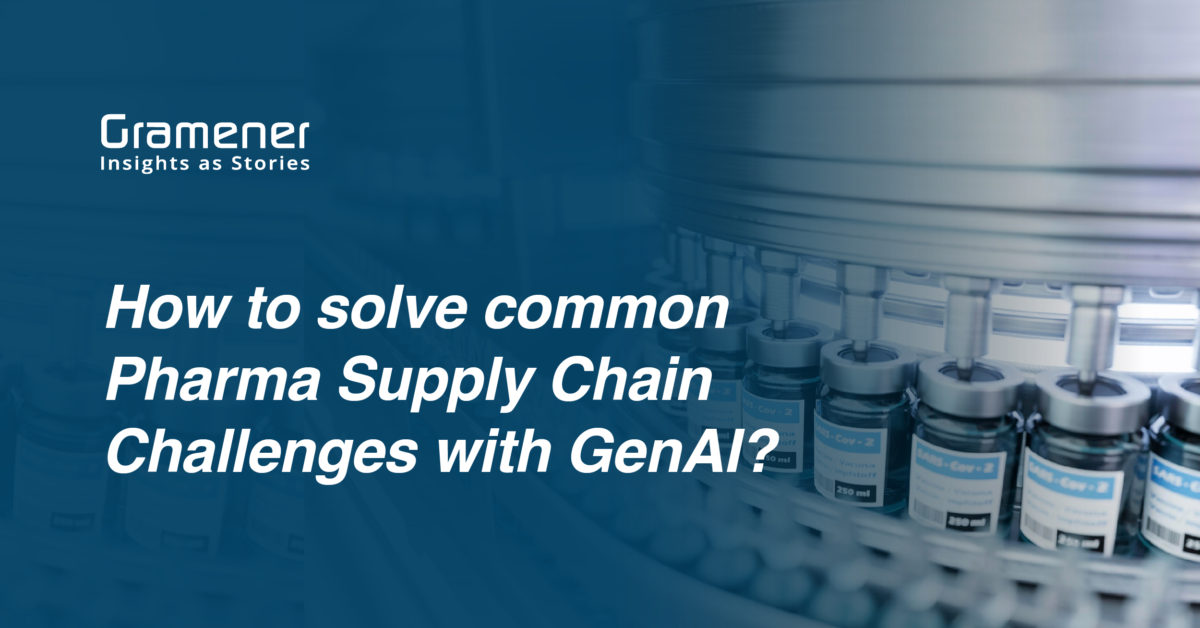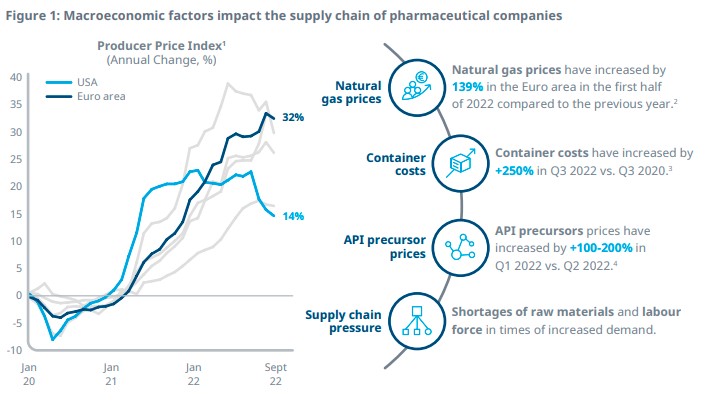Did you know that in 2022, the worldwide market for pharmaceutical supply chain management was estimated at a remarkable $2302.87 million? Projections suggest an impressive growth to $5289.53 million by 2032. This expansion reflects a CAGR of 8.84% throughout the forecast period. Despite its promising market growth, the pharma supply chain is delicate and complex due to various pressing challenges.
The pharma companies face key problems like optimizing R&D processes, diminishing product life spans & patent exclusivity, increased competition from generic alternatives, adherence to production compliance, and rising operational costs.
This blog discussed the top eight pharma supply chain challenges along with feasible solutions.
8 Pharma Supply Chain Challenges & Solving Them with Gen AI
1. No Visibility In The Cold Chain
Companies involved in the pharma cold chain necessitate immediate access to information regarding the status, timing, and location of their products, raw materials, and subcomponents.
The absence of comprehensive data leaves pharmaceutical companies with a limited view, lacking real-time details on the location, temperature, and humidity of their perishable products.
Generative AI enhances visibility in the pharma cold chain by employing real-time tracking and predictive analytics, enabling detailed monitoring of temperature-controlled pharmaceuticals throughout their journey.
It utilizes IoT data and machine learning algorithms to anticipate potential disruptions, environmental changes, and logistics challenges, ensuring optimal conditions are maintained. This increased visibility not only assures compliance with strict regulatory standards but also improves efficiency and reduces the risk of product loss.
2. Temperature Excursions
According to the IQVIA Institute for Human Data Science, the biopharmaceutical sector faces an annual loss of $35 billion due to failures in maintaining temperature control within supply chains. These failures create significant risks to the quality and stability of drugs, as well as compliance for products shipped globally.
For instance, Pfizer’s COVID-19 vaccine requires storage temperatures between -70°C and -60°C, while the Moderna vaccine needs to be kept at standard refrigerator temperatures of 2–8 °C for 30 days during shipping, with long-term storage requiring standard freezer temperatures of -20°C (-4°F) for 6 months.
Deviation from these specified temperature ranges could lead to the spoilage of entire vaccine shipments, resulting in costly consequences such as quarantine or declaring them a complete loss. Clearly, temperature excursions carry substantial financial implications for pharmaceutical companies.
To address the challenge of maintaining precise temperature control within supply chains, pharma companies can use advanced cold chain logistics, real-time temperature monitoring, risk assessment & planning, and streamline regulatory compliance.
3. Real-Time Data Collection
A key obstacle faced by pharmaceutical supply chains is the lack of real-time data collection during transit. Without immediate access to data about your products, addressing anomalies such as temperature excursions becomes difficult.
The identification of root causes for damage or delays becomes particularly difficult without real-time location and condition data. Moreover, the absence of up-to-the-minute data makes it challenging to allocate resources efficiently, as insights into the estimated time of arrival (ETA) are unavailable.
The pharma companies can adopt Gen AI to solve the problem of real-time data collection. Gen AI continuously gathers and analyzes data from heterogeneous sources in the supply chain during transit. This allows it to make instant, intelligent adjustments, ensuring the entire supply chain performs smoothly and efficiently, much like a well-conducted symphony.
4. Maintaining Pharmaceutical Compliance
In recent years, there has been a notable rise in the quantity and complexity of pharma regulatory affairs. Non-compliance can lead to severe adverse impacts on costs, reputation, and the well-being of patients.
For example, a Canadian manufacturing facility that produced injectable drugs faced a suspension of its establishment license by Health Canada due to violations of Good Manufacturing Practice (GMP). At the time, the company supplied 80% of the Canadian market and offered the most cost-effective drug option. The suspension resulted from significant concerns about the manufacturing process. Although the license was partially reinstated within months, the company was barred from manufacturing until new equipment was installed—a process subject to inspection and re-approval.
Leveraging Gen AI for the pharmaceutical regulatory process involves using advanced algorithms that can interpret and integrate evolving regulations and guidelines.
Gen AI can continuously monitor and analyze data across various stages of pharmaceutical development and production, ensuring adherence to quality standards and regulatory requirements. Additionally, it facilitates real-time reporting and decision-making, enabling swift responses to compliance issues and maintaining a consistently high standard of pharmaceutical safety and efficacy.

5. Accurate Demand Forecasting
Accurately forecasting demand creates a significant challenge for professionals in the pharmaceutical supply chain. Achieving timely production and successful delivery of all pharmaceutical products necessitates comprehensive end-to-end visibility. This visibility is essential for maintaining optimal inventory levels, preventing the accumulation of expired stock, implementing safety measures, fulfilling omnichannel orders, and conducting accurate demand forecasting.
Gen AI can help in accurate demand forecasting in the pharmaceutical supply chain by analyzing vast datasets, including historical sales, market trends, and consumer behavior, to predict future demand with high precision. It employs advanced machine learning algorithms that identify patterns and correlations that are not immediately apparent, allowing for more nuanced and accurate forecasts. This enhanced forecasting capability enables pharmaceutical companies to optimize inventory levels, reduce waste, and ensure timely delivery of medications to meet patient needs efficiently.
6. Counterfeit Drugs
The issue of counterfeit drugs presents a significant security challenge that can disrupt the pharmaceutical supply chain. Both organizations and regulatory authorities express profound concerns about this problem, which manifests in various forms, including:
- Incorrect dosage of Active Pharmaceutical Ingredients (APIs)
- Absence of APIs
- Inclusion of harmful ingredients
Unfortunately, producing and distributing fake medicines has become a lucrative enterprise. The World Health Organization (WHO) reports that counterfeit drugs generate approximately US$83 billion in global sales annually.
Duplicate drugs in the pharmaceutical supply chain lead to increased market competition, often resulting in reduced profit margins for original drug manufacturers and potential quality control issues. They also complicate inventory management and can undermine patient trust in pharmaceutical products due to concerns about efficacy and safety.
Gen AI can address the issue of duplicate drugs in the pharmaceutical supply chain by deploying advanced pattern recognition algorithms to identify and flag potential duplicates based on drug composition, packaging, and distribution patterns. By integrating with supply chain databases, Gen AI can trace and verify the authenticity of drugs, helping to distinguish between original and duplicate products. This not only ensures compliance with regulatory standards but also maintains the integrity of the supply chain by safeguarding against counterfeit and unauthorized products.
7. Growth in Home Deliveries
The growing reliance on the internet is leading to a notable expansion of online healthcare services, with the global online pharmaceutical market projected to exceed $180 billion by 2027, as per ABI Research.
This trend is increasing the use of virtual doctor consultations and e-prescriptions, posing challenges for the pharma supply chain in delivering small-sized medications directly to patients. To adapt, the industry is shifting towards micro-fulfillment operations, requiring collaboration between local pharmacies, fulfillment teams, and delivery agents to ensure efficient medication delivery and supply chain integrity.
Gen AI can resolve the challenges posed by the expansion of online healthcare services by optimizing the pharmaceutical supply chain for efficient processing and delivery of e-prescriptions.
It uses predictive analytics to anticipate demand trends and manage inventory, ensuring the timely availability of medications for direct patient delivery. Additionally, Gen AI streamlines logistics and routing, reducing delays and enhancing the accuracy of delivering small-sized medications to patients’ doorsteps.
8. More Dependency on a Single Region
Pharmaceutical supply chains face a major challenge due to dependence on a single region for sourcing critical drug components like Active Pharmaceutical Ingredients (APIs). This reliance becomes problematic during regional crises like military conflicts or natural disasters, disrupting supply and causing delays in medication delivery.
Recognizing this, entities like the U.S. Pharmacopeia have highlighted the concentration of API production in specific regions (e.g., India’s 114 facilities versus the U.S.’s 3), prompting countries like the United States and Austria to consider relocating pharmaceutical manufacturing closer to home.
Gen AI can resolve the challenge of regional dependency in pharmaceutical supply chains by enabling more efficient and diversified sourcing strategies. It analyzes global market trends, production capacities, and geopolitical risks to identify alternative sources for Active Pharmaceutical Ingredients (APIs). This approach enhances supply chain resilience, reduces reliance on a single region, and ensures a more stable supply of essential drug components.
In addition, some microeconomic factors impact the supply chain of pharmaceutical companies:
In the above image, we show the prominent microeconomic factors that impact the pharma supply chain. These factors are natural gas prices, container costs, API precursor prices, and shortage of raw materials and labor forces.
Streamline Your Pharma Supply Chain With Gen AI
Gen AI’s Large Language Models (LLMs) are significantly transforming the pharmaceutical supply chain by providing enhanced visibility and integrating diverse real-time data sources. Check out some of our latest projects in Generative AI with notable companies, including the pharmaceutical industry.
This integration leads to improved demand forecasting, optimized inventory, and streamlined distribution, making the supply chain more responsive and cost-effective.
As an early Gen AI adopter, Gramener leverages these technologies to address challenges in demand forecasting, inventory management, and distribution, thus enabling pharmaceutical companies to create resilient, efficient supply chains for consistent medicine delivery.




